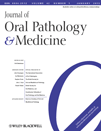Analysis of giant cell tumour of bone cells for Noonan syndrome/Cherubism-related mutations
Abstract
Background: Giant cell tumour of bone (GCTB) is an osteolytic tumour which contains numerous osteoclast-like giant cells and a proliferation of mononuclear stromal cells (MSC). Giant cell-rich osteolytic lesions can also develop in the jaw bones in Noonan syndrome, a cherubism-like developmental abnormality that is transmitted in an autosomal dominant fashion, often because of mutation in the PTPN11 or BRAF genes.
Methods: We screened GCTBs for mutations in PTPN11 and BRAF to determine whether GCTBs develop through alterations of genes involved in Noonan syndrome. MSC were isolated from 10 GCTBs.
Results: Chromosome banding analysis of these cells revealed telomeric associations (tas) in 7 of the 10 cases. Thus, the cultured cells expressed a cytogenetic abnormality typically found in short-term cultures from GCTBs. Sequencing of DNA extracted from the seven GCTB-derived MSC cultures displaying tas did not identify any mutation in PTPN11 or in exons 9–15 of BRAF.
Conclusion: Our findings indicate that the molecular pathways involved in GCTB development are different from those causing Noonan syndrome. The method for isolating and culturing GCTB stromal cells described in this study generated a population of MSC that contained tas, indicating that it is useful for obtaining stromal cells from GCTB and other giant cell-rich lesions, such as giant cell reparative granuloma, for genetic and other studies.




